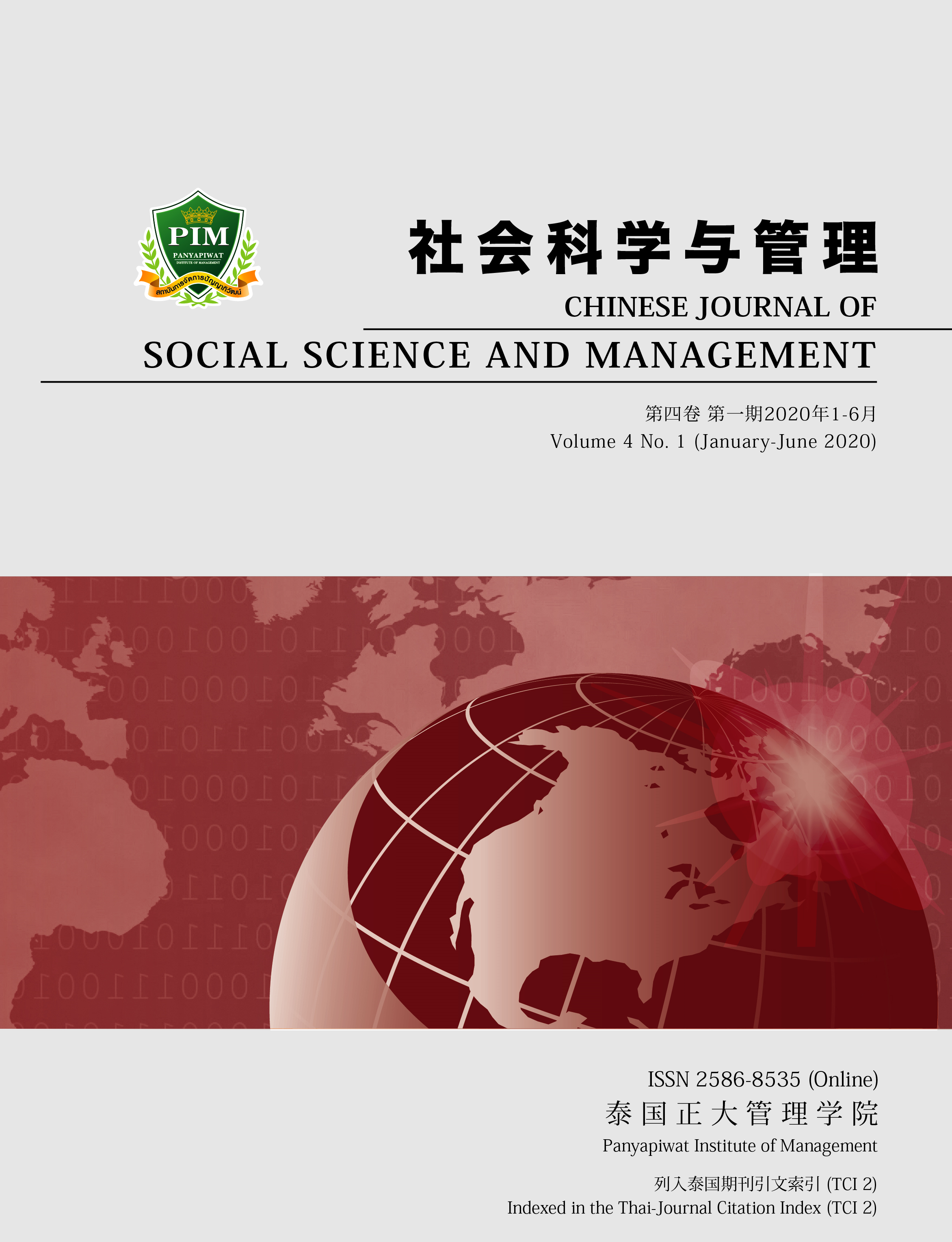CHINESE STUDENTS’ PERCEPTIONS TOWARD IMPLEMENTATION OF ENGLISH IMMERSION
Main Article Content
Abstract
Abstract
The research results showed that over half of participants indicated their positive attitude toward the implementing of structured English Immersion at CAIC fundamental English courses. In addition, another 45 participants were invited for semi-structured interview to collect qualitative data, and 77.8% of participants accepted the implementation of SEI along with providing the fact that SEI brings more considerable strengths than weaknesses. At last, age, academic level and overseas life experiences of participants in the current study were correlated with SEI both positively and negatively.
Article Details
Chinese Journal of Social Science and Management Editorial Division
The Office of Research and Development, Panyapiwat Institute of Management
85/1 Moo 2, Chaengwattana Rd., Bang Talat, Pakkred, Nonthaburi 11120, Thailand
Tel. 02 855 01048 E-mail: cjssm@pim.ac.th
References
Bernard, H. R. (2006). Research Methods in Anthropology: Qualitative and Quantitative Approaches (4th ed.). Oxford: Alta Mira Press.
Chen, H. Y. (2016). Exploring the Application Strategies of Teacher and Student Discourse in the Process of American Immersive Chinese Teaching. Journal of Jiamusi Vocational College, 8, 362-363. [in Chinese]
Colin, B. (2011). Foundations of Bilingual Education and Bilingualism (5th ed.). Clevedon: Multilingual Matters.
Csikszentmihalyi, M. (1975). Beyond Boredom and Anxiety. San Francisco: Jossey- Bass Publishers.
Cui, Y. H. (2017). The development, characteristics and problems of Chinese immersion teaching in primary schools in the United States. World Chinese teaching, 31(1), 116-127. [in Chinese]
Curtain, H. & Carol, A. D. (2010). Language and Children: Making the Match: Bringing New Language to Young Learners K8 (4th ed). Boston: Pearson (Allyn & Bacon).
Dong, X. (2017). The application research of immersive teaching method in college foreign language teaching. Heilongjiang animal husbandry and veterinary, 5, 267-269. [in Chinese]
Dong, X. (2018). The immersion teaching of American primary school SEI structure and its enlightenment. Teaching and Management, 12(2), 122-124. [in Chinese]
Fern, V., Anstrom, K. & Silcox, B. (1995). Active learning and the limited English proficient student. Directions in Language Education, 1, 1-7.
Fortier, D. (1990). Rapport Annuel 1989. Commissaire aux langues offcielles. Ottawa:Ministere des Approvisionnemeuiset Service Canada.
Genesee, F. (1985). Second language learning through immersion: A review of U. S. program. Review of Educational Research, 55, 541-561.
Genesee, F. (1994). Integrating Language and Content: Lessons from Immersion. Educational Practice Reports. No 11. National Center for Research on Cultural Diversity and Second Language Learning. Washington, DC: Center for Applied Linguistics.
Genesee, F., Holobow, N., Lambert, W. E. & Walling, R. (1985). The linguistic and academic development of English-speaking children in French school: Grade 4 outcomes. Canadian Modem Language Review, 41, 669-685.
Hymes, D. (1971). On Communicative Competence. In J. Pride and J. Holmes (Eds.), Sociolinguistics. Penguin, 1972. Excerpt from the paper published 1971, Philadelphia: University of Pennsylvania Press.
Krashen, S. D. & Terrell, T. D. (1983). The Natural Approach: Language Acquisition in the Classroom. San Francisco: The Alemany Press, 37.
Li, D. Q. (2014). A review of the immersion teaching program at the Bright Chinese School in Minnesota, USA. Overseas Chinese Teaching Research, 3, 14-16. [in Chinese]
Mohan, B. (1986). Language and Content. Reading, MA: Addison Wesley.
Onwuegbuzie, A. & Johnson, R. (2006). The validity issue in mixed research. Research in the Schools, 1, 48-63.
Ouyang, W. X. (2018). The application of immersion teaching method in primary school English teaching. Basic education, 1, 241-243. [in Chinese]
Pei, M. (2005). From the perspective of social culture, this paper analyzes the interaction behavior between teachers and students in English immersion classroom- theoretical analysis. Doctoral Dissertation. Hong Kong University. [in Chinese]
Piaget, J. (1959). The Language and Thought of Child (3rd ed.) London: Routledge and Kegan Paul. (Original work published 1923).
Qiang, H. Y. & Siegel, L. (2004). An overview of the development of Canadian second language immersion teaching. Comparative education research,7, 1-7. [in Chinese]
Qiang, H. Y. & Zhao, L. (2000). Canadian second language immersion teaching and its reference in China. Comparative education research, 4, 38-41. [in Chinese]
Snow, M. (2001). Content-based and immersion models for second and foreign language teaching. In Celce-Murica M (ed.). Teaching English as a Second or Foreign Language (3rd ed.). Boston, MA: Heinle & Heinle.
Snow, M., Met, M. & Genesee, F. (1989). A conceptual framework for the integration of language and content in second/foreign language instruction. TESOL Quarterly, 23, 201-217.
Swain, M. (1985). Communicative competence: Some roles of comprehensible input and comprehensible output in its development. Input in Second Language Acquisition. Rowley, MA: Newbury House.
Tang, S. H. (2017). Talking about the Application of Immersive Teaching in Bilingual Education of Tourism Majors. Weekly, 18, 10-11. [in Chinese]
Vygotsky, L. S. (1978). Mind in Society: The development of higher psychological processes. Cambridge, MA: Harvard University Press.
Wang, Z. (1995). Canadian “immersive” French teaching. Foreign language teaching abroad, 1, 5-8. [in Chinese]
Xia, H. (2015). The Enlightenment of Immersive Teaching on the Reform of Oral English Classroom Teaching in Higher Vocational International Trade. Journal of Nanjing Radio and Television University, 2, 47-49. [in Chinese]
Xie, Q. (2013). American Immersive Teaching and Its Implications for Chinese Bilingual Teaching. Journal of Lishui University, 35(1), 107-113. [in Chinese]
Yu, L. & Zhou, C. F. (2012). On the mode and practice of immersion teaching in higher education in China. Henan Social Sciences, 20(6), 78-80. [in Chinese]
Yu, X. (2009). The Enlightenment of Canadian Immersive Teaching on English Teaching in Middle Schools in China. Journal of Chongqing Three Gorges University, 25(115), 158-160. [in Chinese]
Yuan, P. H. (2011). Immersive bilingual education at the University of Ottawa, Canada and its implications for Chinese college English teaching. Foreign language world, 145(4), 75-82. [in Chinese]
Zhang, L. (2017). The enlightenment of immersive teaching on English oral classroom teaching under the mode of Sino-foreign cooperative education. Journal of Tonghua Teachers College, 38(12), 119-122. [in Chinese]


